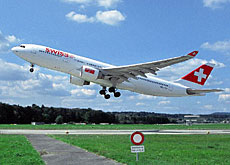Growth forecasts divide economists

The new year is set to mark a return to growth in Switzerland but economic experts are divided on the extent of the recovery.
Estimates for GDP growth are modest, ranging from 0.9-1.9 per cent.
In the latest forecast, Jean-Pierre Roth, chairman of the Swiss National Bank, said the economy would grow by 1.5 per cent as export demand began to rise.
This contrasts with a more cautious prediction of 0.9 per cent by Switzerland’s leading economic barometer, issued by the KOF Institute for Business Cycle Research.
Lausanne’s Créa institute has forecast growth of one per cent, while Basel’s BAK institute puts the figure at 1.3 per cent.
The Swiss government has said growth would be 1.5 per cent and the Organisation for Economic Co-operation and Development (OECD) is going for 1.9 per cent.
Margin of error
Predictions differ because each institution adopts its own methodology for assessing potential growth, including market statistics, surveys and economic modelling.
“There are many sophisticated models for forecasting, but being too sophisticated isn’t of much use,” said Fernando Martins da Silva, head of strategy for the Vaud Cantonal Bank.
“These models do not take into account random elements.”
Da Silva said these included human factors like psychology, as well as unpredictable events such as fuel price hikes, movements in exchange rates or acts of terrorism.
Aurelio Mattei, an economics professor Lausanne University, has analysed the margin of error among forecasters over the last 20 years.
On average, the error is plus or minus one percentage point. This means that growth for 2004 could range between less than one per cent and as much as three.
“When economists are forecasting growth, they should give a spread of between one and two per cent, rather than try to work it out precisely,” Mattei told swissinfo.
Public service
Beat Kappeler, a prominent business commentator, said having a variety of forecasts was useful.
“It’s a real public service,” he said. “You can work out an average from all these sources, and it pushes the forecasters to be more efficient.”
Kappeler also said he relied on external indicators to predict economic trends in Switzerland, which are heavily influenced by outside factors.
Da Silva said that since the start of the current economic cycle, the dips and climbs of the economy have been supply driven rather than related to demand.
Two phenomena have contributed to this change – overinvestment during the late 1990s and a shift towards manufacturing in emerging economies such as India and China.
swissinfo
Economic forecasters predict GDP growth in Switzerland of between 0.9 per cent and 1.9 per cent in 2004.
The Swiss Market Index (SMI) hit an 18-month high during the first day of trade in 2004.

In compliance with the JTI standards
More: SWI swissinfo.ch certified by the Journalism Trust Initiative










You can find an overview of ongoing debates with our journalists here . Please join us!
If you want to start a conversation about a topic raised in this article or want to report factual errors, email us at english@swissinfo.ch.